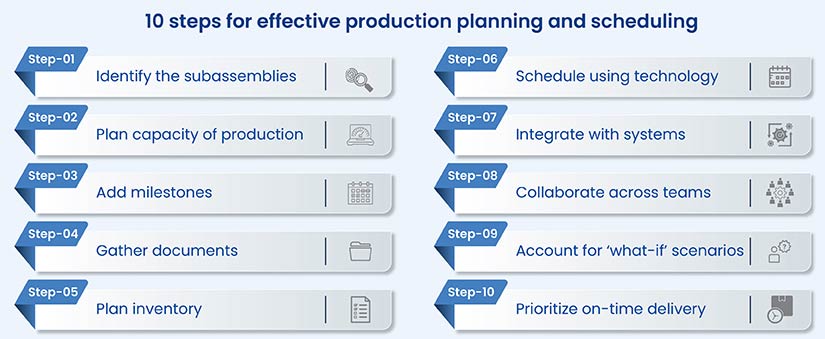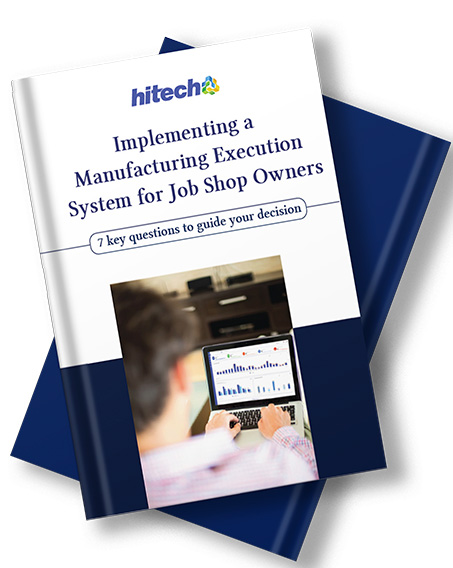- Detailed production planning and scheduling ensure efficient resource allocation and streamline production.
- Production efficiencies can be further enhanced by using software tools like MES for creating master production schedules.
- MES software promote greater collaboration and flexibility across departments and help manufacturers stay agile.
Efficient order planning and scheduling form a sturdy backbone in architectural millwork manufacturing, holding the intricate web of production processes together. This primarily involves managing interim and final production timelines, coordinating vendor and in-house processes, and overseeing internal approvals. Furthermore, it includes obtaining approval from and coordinating with clients, establishing a solid foundation for seamless, end-to-end production.
But, what do we mean when we talk about “planning and scheduling” in manufacturing orders? Planning is the foundation and blueprint for production – the what, where, when, and how. Scheduling, in contrast, is the master clock. It determines the precise moments each cog in the production machinery turns, accounting for both manpower and materials. A powerful production planning and scheduling software can create robust plans to enhance operational efficiency and drive profitability.
Table of Contents
- Planning and Scheduling Challenges Faced by Manufacturers
- 10 steps to Effectively Schedule and Plan Manufacturing Orders
- Step 1: Identify the Subassemblies for Each Order
- Step 2: Decide on In-House Production or Subcontracting
- Step 3: Add Milestones and Dependencies
- Step 4: Collate Your Documents and Production Information
- Step 5: Optimize Inventory Management
- Step 6: Use Technology to Optimize Scheduling
- Step 7: System Integration
- Step 8: Collaborate Across Departments
- Step 9: Use a Dynamic Schedule with What-If Scenarios
- Step 10: Prioritize On-Time Delivery
- Conclusion
Planning and Scheduling Challenges Faced by Manufacturers

All manufacturers across the millwork industry have unique challenges for production planning and scheduling. It largely depends on their projects and type of product being manufactured. However, major challenges include:
- Manual tracking & scheduling
- Missed milestones / approvals
- Lack of coordination with subcontractors
- Limited visibility into available resources
- Limited shop floor visibility
- Start and stop time of jobs
- Inability to meet demand fluctuations
10 steps to Effectively Schedule and Plan Manufacturing Orders

Step 1: Identify the Subassemblies for Each Order
Central to an optimized manufacturing process is a profound understanding of each constituent component and its place in the production tapestry. Particularly in fields like furniture fabrication, where pieces are intricate, the recognition, organization, and preparedness for each subassembly play a pivotal role.
Imagine constructing a grand clock tower; each gear and sprocket must be acknowledged for the clock to function perfectly. Similarly, MES software illuminate this process, offering a microscopic and panoramic view of each subassembly. They facilitate accurate identification, proactive tracking, and agile management of components. The precision and efficiency offered by MES tools ensure the production machinery operates with minimal disruptions and aligns impeccably with design expectations.
Step 2: Decide on In-House Production or Subcontracting
One of the foundational decisions in manufacturing concerns striking a balance between in-house production and subcontracting. These decisions cast ripples across cost structures, delivery timelines, and even the overarching quality of the product.
In manufacturing, MES tools are invaluable allies in this decision matrix. They provide insights into production speeds, financial implications, and resource availability, thereby ensuring that choices regarding in-house production or subcontracting align with the enterprise’s strategic objectives and are consistent with customer expectations.
Confused about the role of MES software for SMBs?
Read our MES guide to know all about the manufacturing software you may want to implement for your job shop.
Step 3: Add Milestones and Dependencies
Imagine setting out on a cross-country road trip. Just as detailed markers, pitstops, and route dependencies are crucial for a smooth journey, a similar level of intricacy is required in mapping the production process in manufacturing. Clear milestones, akin to the signposts on a highway, dictate the pace, and sequence of the production journey.
Furthermore, recognizing the interdependence between these milestones ensures no step is overlooked. Herein lies the prowess of MES tools. They not only provide a platform to demarcate, monitor, and manage these milestones but also act as navigational aids, ensuring potential detours or roadblocks are anticipated, addressed, and resolved in a timely fashion.
Step 4: Collate Your Documents and Production Information
The manufacturing industry thrives on information consistency, much like a library thrives on organized collections. Every piece of data, be it a design schematic, a material specification, or a quality certification, acts as a chapter in the production story.
MES tools, in this narrative, act as the enormous, all-encompassing source of data. They ensure that every piece of information is cataloged, archived, and made accessible. By centralizing documentation, MES tools ensure a homogenized knowledge base, reducing inconsistencies, ensuring stakeholders are always on the same page, and significantly mitigating errors born from information disparities.
Step 5: Optimize Inventory Management
Inventory management is a cornerstone of effective manufacturing. A precise inventory control system is akin to a well-oiled machine that ensures optimal resource availability and minimizes wastage.
Overstocking ties up capital and demands more storage space, while understocking can halt production, leading to potential losses and dissatisfied customers.
MES tools are instrumental in navigating these challenges. They dive deep into historical data, analyzing past consumption patterns and sales, which, when combined with current demand, help sculpt an informed inventory landscape. Predictive algorithms within these tools further refine this approach by predicting future trends with demand forecasting, allowing manufacturers to proactively adjust stock levels. By doing so, manufacturers can operate lean, reduce holding costs and ensure they’re always ready to meet demand.

Implementing an MES for job shop owners
- Do you still manually plan production?
- Can you track and trace all manufacturing orders?
- How updated are your reports on machine availability?
- Ask many more questions like this to assess your job shop’s maturity.
Step 6: Use Technology to Optimize Scheduling
Ensuring each part of the production process is timed perfectly is essential to prevent production bottlenecks and underutilization of resources. MES tools are adept at addressing this challenge by offering a solid framework for dynamic manufacturing scheduling. These tools employ advanced algorithms that consider various factors, from resource availability to task duration, in shaping the production schedule.
Additionally, the real-time data insights provided by MES tools enable flexible schedule adaptations. This responsiveness allows manufacturers to accommodate unforeseen challenges or shifts in demand, ensuring that operations continue to run smoothly and efficiently.
Step 7: System Integration
Holistic manufacturing requires a seamless flow of information across different systems, from procurement to production. This unified view ensures that each department’s actions align with the broader company objectives. MES tools facilitate this integration, merging data from different systems to provide a comprehensive view of operations. This interconnectedness fosters better decision-making and ensures that each system’s output complements the other.
Step 8: Collaborate Across Departments
In today’s complex manufacturing landscape, collaboration is more than just a buzzword; it’s a necessity. The interplay between departments, whether it’s sales forecasting influencing production or feedback from the supply chain impacting procurement, can make or break efficiency.
MES tools act as a bridge to foster collaboration. By providing a shared data environment, they ensure all departments have access to the same, up-to-date information. Regular data updates and real-time insights promote proactive communication between departments. As a result, barriers are broken down, information flows smoothly, and the entire manufacturing operation benefits from enhanced synchronicity and shared objectives.
Step 9: Use a Dynamic Schedule with What-If Scenarios
In the rapidly changing world of manufacturing, adaptability is essential. Traditional static schedules can quickly become obsolete in the face of unexpected challenges or market changes. Therefore, the ability to model potential scenarios and adjust accordingly is invaluable. MES tools cater precisely to this need. They enable manufacturers to design dynamic schedules that can be quickly adjusted.
Additionally, the ‘what-if’ scenario modeling capabilities of MES allow anticipating potential challenges and facilitate proactive planning. Whether it’s a sudden surge in demand, a supply chain disruption, or an unplanned machinery downtime, MES tools provide the agility to recalibrate schedules swiftly, ensuring minimal disruptions and continued production efficiency.
Step 10: Prioritize On-Time Delivery
While the journey is important, reaching the destination on time, in the world of manufacturing, is often the ultimate goal. Every stakeholder, from the client placing the order to the end consumer, values timely delivery. MES tools bolster this commitment to punctuality. Through real-time tracking, manufacturers can monitor every stage of the production process.
Analytics within these tools offer insights into potential delays or bottlenecks, allowing for proactive interventions. This continuous monitoring and the resulting insights ensure that the entire production chain, from the procurement of raw materials to the shipping of the final product, is geared towards honoring delivery timelines, upholding the manufacturer’s reputation and ensuring customer satisfaction.
Take a closer look at Hitechi2i – a powerful MES software
Interact with our product team and see how Hitechi2i’s powerful features can address your unique challenges.
Conclusion
The manufacturing landscape, marked by its complexity and the need for precision, requires a deep understanding and strategic planning at every step. With ten pivotal stages, job shop manufacturers can efficiently plan and schedule manufacturing orders. Right from identifying subassemblies to managing inventory and everything in between including sub-contracting VS in-house production, setting milestones and documentation, each stage is crucial in meeting final delivery timelines.
In today’s competitive market, the significance of efficient order planning cannot be overstated. It’s not just about producing an item; it’s about optimizing resources, minimizing waste, ensuring timely deliveries, and ultimately, guaranteeing customer satisfaction. The right planning can mean the difference between a thriving manufacturing operation and one that struggles to meet its commitments.
To all manufacturers poised on the edge of decision-making: Embrace these strategies, leverage tools like MES, and integrate these principles into your core operations. The promise is not just an improvement in processes, but a transformative shift towards excellence, ensuring your manufacturing operations are both efficient and effective in meeting the demands of the modern world.





